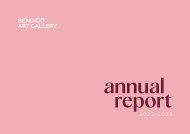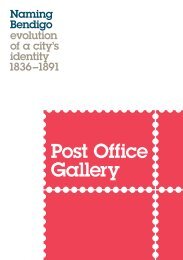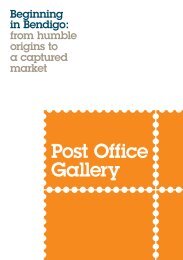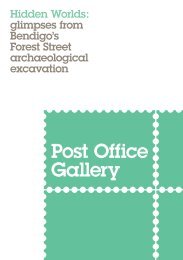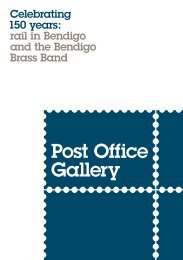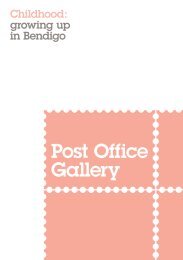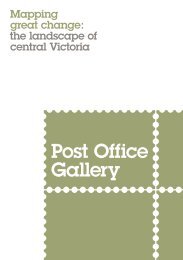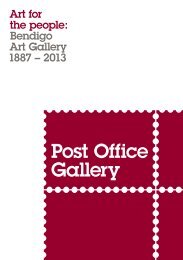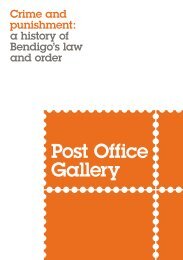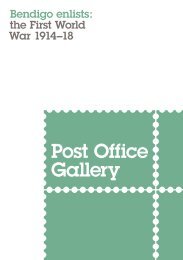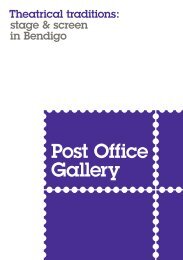A cure for all ills: medicine in Bendigo
This electronic publication accompanies the exhibition A cure for all ills: medicine in Bendigo. From chaotic beginnings to the formation of professional practice, the introduction of regulations against quackery and the establishment of long standing institutions such as Bendigo Hospital, A cure for all ills: medicine in Bendigo explored the social history surrounding the foundations of healthcare in Bendigo and the contribution of doctors, pharmacists, dentists, nurses and Chinese herbalists in providing essential health services to the community.
This electronic publication accompanies the exhibition A cure for all ills: medicine in Bendigo.
From chaotic beginnings to the formation of professional practice, the introduction of regulations against quackery and the establishment of long standing institutions such as Bendigo Hospital, A cure for all ills: medicine in Bendigo explored the social history surrounding the foundations of healthcare in Bendigo and the contribution of doctors, pharmacists, dentists, nurses and Chinese herbalists in providing essential health services to the community.
You also want an ePaper? Increase the reach of your titles
YUMPU automatically turns print PDFs into web optimized ePapers that Google loves.
A <strong>cure</strong><br />
<strong>for</strong> <strong>all</strong> <strong>ills</strong>:<br />
<strong>medic<strong>in</strong>e</strong><br />
<strong>in</strong> <strong>Bendigo</strong><br />
1
a satellite space of<br />
<strong>Bendigo</strong> Art G<strong>all</strong>ery<br />
42 View Street<br />
<strong>Bendigo</strong>, Victoria 3550 Australia<br />
www.bendigoartg<strong>all</strong>ery.com.au<br />
Published 2014<br />
Copyright © <strong>Bendigo</strong> Art G<strong>all</strong>ery 2014<br />
This work is copyright. Apart from any use as permitted under the<br />
Copyright Act 1968, no part may be reproduced by any process<br />
without prior written permission.<br />
Typeset and pr<strong>in</strong>ted <strong>in</strong> Australia by <strong>Bendigo</strong> Modern Press<br />
www.bmp.com.au<br />
National Library of Australia<br />
Catalogu<strong>in</strong>g-<strong>in</strong>-Publication data:<br />
Needham, Clare<br />
A <strong>cure</strong> <strong>for</strong> <strong>all</strong> <strong>ills</strong>: <strong>medic<strong>in</strong>e</strong> <strong>in</strong> <strong>Bendigo</strong><br />
Needham, Clare; Qu<strong>in</strong>lan, Karen<br />
ISBN: 9780949215758 (pbk.)<br />
Medic<strong>in</strong>e--Victoria--<strong>Bendigo</strong>--History--Exhibitions.<br />
Family <strong>medic<strong>in</strong>e</strong>--Victoria--<strong>Bendigo</strong>--History--Exhibitions.<br />
Medical care--Victoria--<strong>Bendigo</strong>--History--Exhibitions.<br />
<strong>Bendigo</strong> (Vic.)--Social life and customs--Exhibitions.<br />
<strong>Bendigo</strong> (Vic.)--Social conditions--Exhibitions.<br />
<strong>Bendigo</strong> (Vic.)--History--Exhibitions.<br />
Other Authors/Contributors:<br />
Qu<strong>in</strong>lan, Karen. Hill, Ian – photographer. <strong>Bendigo</strong> Art G<strong>all</strong>ery.<br />
610.99454<br />
Exhibition venue:<br />
Post Office G<strong>all</strong>ery, 51-67 P<strong>all</strong> M<strong>all</strong>, <strong>Bendigo</strong>.<br />
Exhibition dates:<br />
7 February – 10 August 2014<br />
A <strong>cure</strong><br />
<strong>for</strong> <strong>all</strong> <strong>ills</strong>:<br />
<strong>medic<strong>in</strong>e</strong><br />
<strong>in</strong> <strong>Bendigo</strong><br />
Post Office G<strong>all</strong>ery and <strong>Bendigo</strong> Art G<strong>all</strong>ery are proudly<br />
owned and operated by the City of Greater <strong>Bendigo</strong> with<br />
support from Arts Victoria.<br />
First year students and tutor<br />
<strong>in</strong> Prac Room [detail]<br />
c1967<br />
gelat<strong>in</strong> silver pr<strong>in</strong>t<br />
Collection Northern<br />
Media sponsor<br />
District School of<br />
Nurs<strong>in</strong>g Graduates<br />
Association<br />
2 1
Introduction<br />
The new <strong>Bendigo</strong> Hospital will<br />
be the largest regional hospital<br />
development <strong>in</strong> Victoria’s history and<br />
one of the largest hospital projects <strong>in</strong><br />
Australia. It will provide healthcare<br />
services to a vast geographical area and<br />
br<strong>in</strong>g significant economic benefit to<br />
<strong>Bendigo</strong>. With such momentous growth<br />
<strong>in</strong> <strong>Bendigo</strong>’s healthcare sector it seemed<br />
an opportune time to look back on<br />
the makeshift and somewhat chaotic<br />
beg<strong>in</strong>n<strong>in</strong>gs of <strong>medic<strong>in</strong>e</strong> <strong>in</strong> <strong>Bendigo</strong><br />
and chart how far we have come. To<br />
this end, the exhibition A <strong>cure</strong> <strong>for</strong> <strong>all</strong><br />
<strong>ills</strong>: <strong>medic<strong>in</strong>e</strong> <strong>in</strong> <strong>Bendigo</strong> explores the<br />
social history, advances and professional<br />
foundations of healthcare <strong>in</strong> <strong>Bendigo</strong>.<br />
Post Office G<strong>all</strong>ery’s local lenders<br />
and supporters are an <strong>in</strong>tegral part of<br />
the success of the G<strong>all</strong>ery and each<br />
exhibition. For their commitment<br />
to the preservation of our region’s<br />
long and proud history and their<br />
generosity <strong>in</strong> shar<strong>in</strong>g their knowledge<br />
and collections with the broader<br />
community, thank you to: Janet<br />
Clemens; Carol Holsworth; Aylene<br />
Kirkwood; Peter Marcollo; Dennis<br />
O’Hoy; Darren Wright; the Northern<br />
District School of Nurs<strong>in</strong>g Graduates<br />
Association; <strong>Bendigo</strong> Health,<br />
namely Angela G<strong>all</strong>agher, Librarian,<br />
Organisational Development and<br />
Archives Centre; Elmore Progress<br />
Association Museum and Eaglehawk<br />
Heritage Society. I would also like to<br />
thank the Henry Forman Atk<strong>in</strong>son<br />
Dental Museum, Melbourne University<br />
<strong>for</strong> loans from their collection and<br />
Louise Murray, Curator <strong>for</strong> her<br />
assistance.<br />
I’d like to thank Clare Needham,<br />
Curator of City History and<br />
Collections <strong>for</strong> curat<strong>in</strong>g this exhibition<br />
and <strong>for</strong> her ongo<strong>in</strong>g management<br />
of Post Office G<strong>all</strong>ery operations.<br />
Thank you also to <strong>in</strong>tern Kate Eastick<br />
<strong>for</strong> her assistance. I acknowledge the<br />
technical team of <strong>Bendigo</strong> Art G<strong>all</strong>ery<br />
<strong>for</strong> <strong>in</strong>st<strong>all</strong><strong>in</strong>g the exhibiton and I<br />
wish to highlight especi<strong>all</strong>y the Post<br />
Office G<strong>all</strong>ery volunteers, who make<br />
a significant contribution to visitors’<br />
experience at the G<strong>all</strong>ery.<br />
Karen Qu<strong>in</strong>lan<br />
DIRECTOR, BENDIGO ART GALLERY<br />
Maurice Pease<br />
Pharmacy,<br />
Hargreaves Street,<br />
<strong>Bendigo</strong> [detail]<br />
L to R: Janet<br />
Clemens, Maurice<br />
Pease, Stuart<br />
Anderson and<br />
Rene Truscott<br />
1952<br />
gelat<strong>in</strong> silver pr<strong>in</strong>t<br />
Collection Janet<br />
Clemens<br />
Improvement; <strong>Bendigo</strong> Regional<br />
2 3
A <strong>cure</strong> <strong>for</strong> <strong>all</strong> <strong>ills</strong>:<br />
<strong>medic<strong>in</strong>e</strong> <strong>in</strong> <strong>Bendigo</strong><br />
Today it is relatively straight<strong>for</strong>ward<br />
to visit your local doctor, get a tooth<br />
fixed at the dentist, a prescription<br />
filled at the pharmacy or seek<br />
alternative remedies outside the<br />
framework of ma<strong>in</strong>stream <strong>medic<strong>in</strong>e</strong>.<br />
Public healthcare structures like<br />
Medicare make this process relatively<br />
af<strong>for</strong>dable. S<strong>in</strong>ce the arrival of<br />
Europeans the healthcare system<br />
<strong>in</strong> Australia has grown to become<br />
an ecology of vary<strong>in</strong>g discipl<strong>in</strong>es,<br />
work<strong>in</strong>g cohesively to manage the vast<br />
array of health problems experienced<br />
by the general population on a<br />
daily basis. However, it was a very<br />
different story <strong>in</strong> the mid 1800s when<br />
thousands flocked to the <strong>Bendigo</strong><br />
goldfields seek<strong>in</strong>g their <strong>for</strong>tune.<br />
From chaotic beg<strong>in</strong>n<strong>in</strong>gs to the<br />
<strong>for</strong>mation of professional practice, the<br />
<strong>in</strong>troduction of regulations aga<strong>in</strong>st<br />
quackery 1 and the establishment of<br />
long stand<strong>in</strong>g <strong>in</strong>stitutions such as<br />
<strong>Bendigo</strong> hospital, A <strong>cure</strong> <strong>for</strong> <strong>all</strong> <strong>ills</strong>:<br />
<strong>medic<strong>in</strong>e</strong> <strong>in</strong> <strong>Bendigo</strong> explores some<br />
of the social history surround<strong>in</strong>g<br />
the foundations of healthcare <strong>in</strong><br />
<strong>Bendigo</strong> and the contribution of<br />
doctors, pharmacists, dentists, nurses<br />
and Ch<strong>in</strong>ese herbalists <strong>in</strong> provid<strong>in</strong>g<br />
essential health services to the<br />
community.<br />
Primitive beg<strong>in</strong>n<strong>in</strong>gs<br />
Early doctors on the goldfields<br />
were pioneers work<strong>in</strong>g <strong>in</strong> makeshift<br />
conditions. Overcrowd<strong>in</strong>g, lack of<br />
water, almost no provision <strong>for</strong> the<br />
disposal of garbage or sewage, swarms<br />
of flies and poor food storage meant<br />
that disease was rife. 2 Accidental<br />
<strong>in</strong>juries such as gunshot wounds,<br />
or broken limbs from poorly built<br />
m<strong>in</strong>e shafts were also common.<br />
Many medic<strong>all</strong>y tra<strong>in</strong>ed men came<br />
to <strong>Bendigo</strong> not to practice <strong>medic<strong>in</strong>e</strong><br />
but to dig <strong>for</strong> gold, nevertheless after<br />
survey<strong>in</strong>g the pitiful conditions and<br />
discover<strong>in</strong>g that m<strong>in</strong><strong>in</strong>g was a rather<br />
chancy enterprise, many set up a<br />
tent and advertised their professional<br />
services.<br />
Despite most charg<strong>in</strong>g a substantial<br />
fee <strong>for</strong> a consultation, be<strong>in</strong>g a doctor<br />
on the chaotic goldfields was an<br />
unenviable task. Isolated from centres<br />
of learn<strong>in</strong>g and their fellow colleagues<br />
<strong>in</strong> Brita<strong>in</strong>, with no hospital, nurses or<br />
general anesthetic, early procedures<br />
would have been brutal; and there was<br />
often little that could be done other<br />
than to ease the patient’s pa<strong>in</strong> until<br />
their recovery or death.<br />
Official healthcare provisions on<br />
the <strong>Bendigo</strong> Creek digg<strong>in</strong>gs began <strong>in</strong><br />
April 1852 when Dr James McCrea<br />
Syr<strong>in</strong>ges and needles<br />
20cc, 10cc and 2cc<br />
early 20th century<br />
glass, surgical steel<br />
Collection Elmore<br />
Progress Association<br />
Museum<br />
took up an experimental position<br />
encompass<strong>in</strong>g camp surgeon and<br />
coroner, and a temporary canvas<br />
structure was erected <strong>for</strong> the treat<strong>in</strong>g<br />
of patients. 3 At this time, qualified<br />
medical practitioners, although a<br />
m<strong>in</strong>ority on the <strong>Bendigo</strong> goldfields,<br />
ga<strong>in</strong>ed the support of local clergy<br />
and began to campaign <strong>for</strong> the<br />
establishment of a more permenant<br />
hospital. Despite an apparent apathy<br />
among the m<strong>in</strong><strong>in</strong>g community<br />
concern<strong>in</strong>g healthcare or enterprises<br />
<strong>for</strong> public benefit, <strong>in</strong> 1853 after<br />
a public meet<strong>in</strong>g, the <strong>Bendigo</strong><br />
Gold District Hospital Board of<br />
Management was elected and money<br />
was collected <strong>for</strong> the hospital’s<br />
construction. 4<br />
The first <strong>Bendigo</strong> hospital<br />
opened <strong>in</strong> November 1853. It was a<br />
weatherboard build<strong>in</strong>g constructed<br />
on a slab, built on a two-acre reserve<br />
on McKenzie Street at the top of<br />
Short Street, known then as ‘Hospital<br />
Hill’. The humble build<strong>in</strong>g <strong>in</strong>cluded<br />
a kitchen and a surgeon’s room; the<br />
first medical super<strong>in</strong>tendent was Dr<br />
Edward Hunt, a ship’s surgeon. 5<br />
Quackery and regulation<br />
In the first year of the <strong>Bendigo</strong><br />
hospital only 20 patients were<br />
admitted, which is surpris<strong>in</strong>g<br />
consider<strong>in</strong>g <strong>Bendigo</strong>’s population of<br />
approximately 40,000 at the time. 6<br />
Unless it was an emergency – with<br />
strict admission rules – it was not easy<br />
to get <strong>in</strong>to the hopsital. Many people<br />
avoided see<strong>in</strong>g a doctor, preferr<strong>in</strong>g<br />
<strong>in</strong>stead to save their money and take a<br />
‘do-it-yourself’ approach to healthcare<br />
or visit a pharmacist. Choos<strong>in</strong>g a<br />
qualified doctor was also a hazardous<br />
affair, s<strong>in</strong>ce at this chaotic time of<br />
rapid growth on the goldfields, there<br />
was no regulation of medical practice.<br />
Quacks and charlatans abounded and<br />
there was noth<strong>in</strong>g prevent<strong>in</strong>g them<br />
assum<strong>in</strong>g a medical title, putt<strong>in</strong>g up a<br />
sign and offer<strong>in</strong>g their services.<br />
One 1850s commentator Mrs E<br />
Clancy noted: ‘It is no joke to get<br />
ill at the digg<strong>in</strong>gs; doctors make<br />
you pay <strong>for</strong> it. Their fees are – <strong>for</strong> a<br />
consultation at their own tent, ten<br />
shill<strong>in</strong>gs; <strong>for</strong> a visit out, from one to<br />
ten pounds, accord<strong>in</strong>g to time and<br />
distance. Many are regular quacks, and<br />
these seem to flourish best.’ 7<br />
With little or no tra<strong>in</strong><strong>in</strong>g, the<br />
remedies and results of these charlatans<br />
were at best mostly <strong>in</strong>effective and<br />
at worst brutal. It was little wonder<br />
that quackery became an ongo<strong>in</strong>g<br />
threat and concern to the medical<br />
4 5
Panorama of <strong>Bendigo</strong><br />
Hospital<br />
late 19th – early<br />
20th centuries<br />
gelat<strong>in</strong> silver pr<strong>in</strong>t<br />
Collection <strong>Bendigo</strong><br />
Health<br />
establishment, tra<strong>in</strong>ed <strong>in</strong> reputable<br />
colleges <strong>in</strong> Brita<strong>in</strong>.<br />
In 1862, after many years of<br />
agitation, an Act regulat<strong>in</strong>g the<br />
practice of <strong>medic<strong>in</strong>e</strong> <strong>in</strong> Victoria<br />
was passed. The Act safeguarded<br />
ethical standards and ensured<br />
mechanisms were <strong>in</strong> place to register<br />
suitably qualified practitioners.<br />
Although the Act did not stamp<br />
out quackery altogether, those who<br />
were unregistered could not take<br />
up official appo<strong>in</strong>tments or write<br />
medical certificates <strong>in</strong>clud<strong>in</strong>g death<br />
certificates. 8<br />
Solid foundations<br />
Just five years after it opened, the<br />
first site of the <strong>Bendigo</strong> hospital was<br />
deemed unsuitable, when strong<br />
w<strong>in</strong>ds almost blew the build<strong>in</strong>g off<br />
its foundations. 9 That same year,<br />
1858, the foundation stone <strong>for</strong> a new<br />
stone-and-brick build<strong>in</strong>g on a tenacre<br />
site on Lucan Street was laid by<br />
The Honourable John O’Shanassey.<br />
The new hospital was designed by<br />
renowned <strong>Bendigo</strong> architects Robert<br />
Getzschmann and William Vahland<br />
and was open by the end of 1858. 10<br />
The new hospital slowly ga<strong>in</strong>ed<br />
momentum and by 1865, the medical<br />
super<strong>in</strong>tendent was jo<strong>in</strong>ed by other<br />
staff <strong>in</strong>clud<strong>in</strong>g a nurse to care <strong>for</strong> an<br />
<strong>in</strong>creas<strong>in</strong>g number of female patients.<br />
The Bowen W<strong>in</strong>g, established <strong>for</strong><br />
the care of women and children, was<br />
opened <strong>in</strong> 1874 with the foundation<br />
stone be<strong>in</strong>g laid the previous year<br />
by Lady Diamant<strong>in</strong>e Bowen, wife<br />
of his Excellency, Sir GF Bowen,<br />
then Governor of Victoria. The<br />
two build<strong>in</strong>gs were connected by a<br />
two-storey covered walkway. Apart<br />
from the Royal Melbourne Hospital,<br />
by the 1880s, the <strong>Bendigo</strong> hospital<br />
was the largest and most important<br />
<strong>in</strong> the colony servic<strong>in</strong>g many sm<strong>all</strong>er<br />
townships across the region. 11<br />
With the services the hospital was<br />
able to provide <strong>for</strong> the community,<br />
it soon became overcrowded and it<br />
was apparent that the hospital alone<br />
was not enough. The goldfields<br />
were burst<strong>in</strong>g at the seams and there<br />
was little <strong>in</strong> place to care <strong>for</strong> the<br />
destitute, the aged and the ment<strong>all</strong>y<br />
and chronic<strong>all</strong>y ill. With dw<strong>in</strong>dl<strong>in</strong>g<br />
prosperity on the digg<strong>in</strong>gs, such<br />
cases were prevalent and examples<br />
of distress<strong>in</strong>g circumstances appeared<br />
regularly <strong>in</strong> the local press. At a<br />
time when similar <strong>in</strong>stitutions were<br />
be<strong>in</strong>g established across Victoria, the<br />
Artery <strong>for</strong>ceps, surgical<br />
thread and surgeons’<br />
needles<br />
mid 20th century<br />
metal, cotton, paper<br />
Collection Elmore<br />
Progress Association<br />
Museum<br />
Follow<strong>in</strong>g page:<br />
Cyril White<br />
Australia 19th century<br />
Nurses Effie Fussell,<br />
Topsy Tyson and others<br />
on the hospital float <strong>for</strong><br />
the Easter Fair Parade<br />
1915<br />
gelat<strong>in</strong> silver pr<strong>in</strong>t<br />
Collection <strong>Bendigo</strong><br />
Health<br />
Artist unknown<br />
Published by<br />
Ebenezer and David<br />
Syme, Melbourne<br />
19th century<br />
Hospital Sunday at<br />
Sandhurst, parade and<br />
service <strong>in</strong> Camp Reserve<br />
Published <strong>in</strong> The<br />
Illustrated Australian<br />
News <strong>for</strong> Home Readers<br />
1873<br />
wood engrav<strong>in</strong>g<br />
Courtesy State<br />
Library of Victoria<br />
6 7
8 9
Previous page:<br />
Hamel and Ferguson<br />
Australia 19th century<br />
Illum<strong>in</strong>ated address<br />
given to Lady Bowen<br />
on the lay<strong>in</strong>g of the<br />
Foundation Stone of the<br />
Bowen W<strong>in</strong>g, <strong>Bendigo</strong><br />
Hospital<br />
1873<br />
paper, cotton,<br />
embossed leather,<br />
<strong>in</strong>k, acrylic pa<strong>in</strong>t<br />
Collection <strong>Bendigo</strong><br />
Health<br />
WH Rob<strong>in</strong>son<br />
Australia 19th century<br />
James Lamsey<br />
1900<br />
gelat<strong>in</strong> silver pr<strong>in</strong>t<br />
Collection Dennis<br />
O’Hoy<br />
<strong>Bendigo</strong> Benevolent Asylum was<br />
opened <strong>in</strong> 1860. Later c<strong>all</strong>ed the<br />
<strong>Bendigo</strong> Home and Hospital <strong>for</strong> the<br />
Aged, the asylum filled an immediate<br />
local need and took pressure off the<br />
hospital.<br />
The ma<strong>in</strong> issue dur<strong>in</strong>g the early<br />
decades of the hospital, and <strong>in</strong>deed<br />
the asylum, was ma<strong>in</strong>ta<strong>in</strong><strong>in</strong>g capital.<br />
A reduction <strong>in</strong> government grants<br />
resulted <strong>in</strong> a significant reliance on<br />
the community to give generously, to<br />
enable essential services to cont<strong>in</strong>ue<br />
to be provided. Despite an <strong>in</strong>itial<br />
lack of <strong>in</strong>terest, the community<br />
ultimately rose to this ch<strong>all</strong>enge with<br />
most of the hospital’s funds com<strong>in</strong>g<br />
from community donations, friendly<br />
societies, schools and annual hospital<br />
subscriptions. In addition, money was<br />
raised each year through charitable<br />
events such as the annual Easter Fair,<br />
established <strong>in</strong> 1871 to raise money <strong>for</strong><br />
both the hospital and the asylum. 12<br />
Another fundrais<strong>in</strong>g measure was<br />
the 1873 <strong>in</strong>troduction of Hospital<br />
Sunday by prom<strong>in</strong>ent <strong>Bendigo</strong>nian<br />
Mr JH Abbott. 13 Inspired by similar<br />
successful events <strong>in</strong> Brita<strong>in</strong>, Hospital<br />
Sunday – like the Easter Fair –<br />
proved to be an effective revenue<br />
raiser. 14<br />
Ancient traditions<br />
While <strong>Bendigo</strong> was establish<strong>in</strong>g<br />
<strong>in</strong>frastructure <strong>for</strong> the practice of<br />
Western <strong>medic<strong>in</strong>e</strong>, among the<br />
Ch<strong>in</strong>ese migrants who came to<br />
the <strong>Bendigo</strong> goldfields <strong>in</strong> pursuit<br />
of gold were those tra<strong>in</strong>ed <strong>in</strong><br />
the ancient traditions of Ch<strong>in</strong>ese<br />
<strong>medic<strong>in</strong>e</strong>. These practitioners<br />
adm<strong>in</strong>istered traditional remedies<br />
to their countrymen, then later to<br />
European migrants who had become<br />
disillusioned with ma<strong>in</strong>stream<br />
doctors and were seek<strong>in</strong>g an<br />
alternative <strong>cure</strong>. Savvy Ch<strong>in</strong>ese<br />
herbalists advertised <strong>in</strong> Englishspeak<strong>in</strong>g<br />
newspapers to attract clients<br />
who would pay good money <strong>for</strong><br />
their services.<br />
In the quest to protect the<br />
<strong>in</strong>terests of the ma<strong>in</strong>stream medical<br />
establishment, it is no surprise<br />
that these ‘<strong>for</strong>eign’ healers were<br />
ostracised. It was considered<br />
acceptable <strong>for</strong> a Ch<strong>in</strong>ese herbalist<br />
to adm<strong>in</strong>ister traditional remedies<br />
to their own countrymen, however<br />
not to treat European clients as<br />
though they were tra<strong>in</strong>ed doctors.<br />
The Victorian Medical Society<br />
discouraged its members from<br />
treat<strong>in</strong>g patients who were also<br />
Ch<strong>in</strong>ese <strong>medic<strong>in</strong>e</strong> bottles<br />
late 19th – early 20th<br />
century<br />
glass, paper, wax<br />
Collection Dennis<br />
O’Hoy<br />
visit<strong>in</strong>g a Ch<strong>in</strong>ese practitioner.<br />
Unregistered, Ch<strong>in</strong>ese herbalists<br />
could not issue death certificates<br />
which could lead to later<br />
implications with coroners and the<br />
law.<br />
The most notable and politic<strong>all</strong>y<br />
active Ch<strong>in</strong>ese herbalist on the<br />
<strong>Bendigo</strong> goldfields was James<br />
Lamsey. Medic<strong>all</strong>y tra<strong>in</strong>ed <strong>in</strong> Ch<strong>in</strong>a<br />
and previously work<strong>in</strong>g <strong>in</strong> the<br />
Canton Hospital, Lamsey arrived<br />
<strong>in</strong> Australia <strong>in</strong> the early 1850s, and<br />
travelled to <strong>Bendigo</strong> <strong>in</strong> the 1870s.<br />
Throughout the late 1800s, there<br />
were numerous attempts by the<br />
Victorian Medical Society to curtail<br />
the activities of Ch<strong>in</strong>ese herbalists.<br />
Several times Lamsey was taken to<br />
court and <strong>in</strong>terrogated <strong>for</strong> operat<strong>in</strong>g<br />
under the illustrious title of doctor. 15<br />
Accord<strong>in</strong>g to local historian Carol<br />
Holsworth, Lamsey and his fellow<br />
herbalists tried regularly to ga<strong>in</strong><br />
registration with the Society but<br />
were denied every time, ‘… not<br />
because of their race or religion, but<br />
because of their lack of anatomical<br />
knowledge and adequate years of<br />
tra<strong>in</strong><strong>in</strong>g.’ 16<br />
Despite be<strong>in</strong>g unsuccessful <strong>in</strong><br />
his campaign to be recognised<br />
as a doctor and to trade under<br />
this title, Lamsey and his fellow<br />
practitioners cont<strong>in</strong>ued their<br />
practices. In a f<strong>in</strong>al ef<strong>for</strong>t to ga<strong>in</strong><br />
professional acknowledgement,<br />
Lamsey tried to become registered<br />
as a pharmacist but was also<br />
unsuccessful. Nonetheless, Lamsey<br />
amassed considerable wealth from<br />
his bus<strong>in</strong>ess activities and ga<strong>in</strong>ed<br />
prom<strong>in</strong>ence <strong>in</strong> both Ch<strong>in</strong>ese and<br />
European circles. 17<br />
Long after Lamsey’s death, th<strong>in</strong>gs<br />
f<strong>in</strong><strong>all</strong>y changed <strong>for</strong> Ch<strong>in</strong>ese herbalists<br />
practic<strong>in</strong>g <strong>in</strong> Victoria when an<br />
amendment to the Pharmaceutical<br />
Chemists Bill was <strong>in</strong>stigated <strong>in</strong> 1925<br />
to regulate the practice of quackery.<br />
Under the title of ‘Herbalists’, it<br />
stated: ‘The several persons named<br />
<strong>in</strong> the schedule to this Act sh<strong>all</strong> be<br />
entitled to cont<strong>in</strong>ue as hereto<strong>for</strong>e<br />
to practice as Herbalists or Herbal<br />
Practitioners and to use the title of<br />
Herbalist or Herbal Practitioner and<br />
to mix prepare and supply medic<strong>in</strong>al<br />
herbs and to give directions <strong>for</strong><br />
their use to persons under their<br />
personal care or treatment ...’ 18 This<br />
amendment was accompanied by a<br />
list of practitioners, <strong>in</strong>clud<strong>in</strong>g several<br />
herbalists from <strong>Bendigo</strong>. 19<br />
10 11
12<br />
Maw & Sons<br />
England 19th – 20th<br />
centuries<br />
Pharmacy bottles<br />
19th century<br />
glass,<br />
powdered rhubarb,<br />
powdered c<strong>in</strong>namon,<br />
Qu<strong>in</strong>n<strong>in</strong>e sulphate,<br />
compound t<strong>in</strong>cture of<br />
lavender<br />
Collection Darren<br />
Wright<br />
TR Jones Dispens<strong>in</strong>g<br />
and Family Chemist<br />
advertisement<br />
Published <strong>in</strong> <strong>Bendigo</strong><br />
Quartzopolis by<br />
FW Niven and Co,<br />
B<strong>all</strong>arat<br />
1893<br />
pr<strong>in</strong>t<br />
Courtesy Darren<br />
Wright<br />
Felton Grimwade<br />
& Co<br />
Melbourne 19th –<br />
20th centuries<br />
Snakebite treatment case<br />
1860s<br />
glass, t<strong>in</strong>, cotton,<br />
paper, caffe<strong>in</strong>e citrate<br />
tablets, condes<br />
crystals, lavender salt<br />
Collection Darren<br />
Wright<br />
Pharmacy<br />
From modest herbal beg<strong>in</strong>n<strong>in</strong>gs,<br />
by the end of the n<strong>in</strong>eteenth century<br />
pharmacy was a thriv<strong>in</strong>g multilayered<br />
bus<strong>in</strong>ess offer<strong>in</strong>g everyth<strong>in</strong>g<br />
from <strong>medic<strong>in</strong>e</strong> and o<strong>in</strong>tments to<br />
toiletries and household products.<br />
Chemist shops were <strong>all</strong>ur<strong>in</strong>g, stocked<br />
full of o<strong>in</strong>tments and <strong>in</strong>gredients <strong>in</strong><br />
bottles of <strong>all</strong> shapes, sizes and colours.<br />
Pharmacists were often the first<br />
port of c<strong>all</strong> <strong>for</strong> medical advice.<br />
In contrast to the expense of a<br />
doctor’s visit, pharmacists offered<br />
an af<strong>for</strong>dable, accessible service.<br />
If age-old home remedies did not<br />
work, pharmacists would diagnose<br />
a compla<strong>in</strong>t and prescribe a <strong>for</strong>m<br />
of <strong>in</strong>expensive medic<strong>in</strong>al treatment<br />
either ready-made or prepared there<br />
and then. Early pharmacists would<br />
often adm<strong>in</strong>ister the <strong>cure</strong> themselves;<br />
this practice was not illegal until<br />
the end of the n<strong>in</strong>eteenth century,<br />
when Australian medical registration<br />
acts barred pharmacists from do<strong>in</strong>g<br />
anyth<strong>in</strong>g that was considered to be<br />
the work of a doctor.<br />
Initi<strong>all</strong>y, many pharmacists started<br />
not as tra<strong>in</strong>ed medical practitioners,<br />
but as shrewd bus<strong>in</strong>essmen who<br />
recognised the lucrative potential of<br />
the over-the-counter health market.<br />
Although requir<strong>in</strong>g a vast knowledge<br />
of the medic<strong>in</strong>al qualities of various<br />
herbs and chemical substances, there<br />
was no expectation a practitioner<br />
would have any tra<strong>in</strong><strong>in</strong>g other<br />
than to have apprenticed under a<br />
senior chemist. Formal tra<strong>in</strong><strong>in</strong>g,<br />
registration and exam<strong>in</strong>ations were<br />
not <strong>in</strong>troduced until later <strong>in</strong> the<br />
n<strong>in</strong>eteenth century.<br />
While experimentation was the<br />
key to advancement, lack of tra<strong>in</strong><strong>in</strong>g<br />
often meant that early prescribed<br />
remedies had vary<strong>in</strong>g effect. Some<br />
worked wonders while others were<br />
virtu<strong>all</strong>y <strong>in</strong>effective, or even worse,<br />
caused additional problems. Just<br />
as <strong>in</strong> other medical professions,<br />
quackery was rife <strong>in</strong> pharmacy with<br />
the production and sale of many<br />
questionable patent and proprietary<br />
<strong>medic<strong>in</strong>e</strong>s, none more famous than<br />
Holloway’s o<strong>in</strong>tment; a concoction<br />
conta<strong>in</strong><strong>in</strong>g largely beeswax and<br />
lanol<strong>in</strong> which swept the world and<br />
ga<strong>in</strong>ed popularity through clever<br />
advertis<strong>in</strong>g campaigns and mass<br />
production. 20<br />
When compound<strong>in</strong>g <strong>medic<strong>in</strong>e</strong>s<br />
and o<strong>in</strong>tments, pharmacists used<br />
an array of <strong>in</strong>gredients, <strong>in</strong>clud<strong>in</strong>g<br />
poisons and narcotics. These<br />
<strong>in</strong>gredients, most commonly arsenic,<br />
13
Dental tools<br />
late 19th – early 20th<br />
century<br />
metal<br />
Collection Peter<br />
Marcollo<br />
were also sold to customers <strong>in</strong> their<br />
pure <strong>for</strong>m. Due to a large number<br />
of regrettable <strong>in</strong>cidences, <strong>in</strong> the<br />
late n<strong>in</strong>eteenth century restrictions<br />
and regulations were <strong>in</strong>troduced<br />
regard<strong>in</strong>g the sale and keep<strong>in</strong>g of<br />
poisons and later the sale of narcotics.<br />
Cases of accidental poison<strong>in</strong>g were<br />
common and were regularly reported<br />
<strong>in</strong> the local press. The <strong>Bendigo</strong><br />
Advertiser on 9 January 1873 reports:<br />
The sad and untimely death of the<br />
young man George James Cox on<br />
Tuesday morn<strong>in</strong>g at the Railway<br />
Hotel, should prove a warn<strong>in</strong>g to<br />
<strong>all</strong> persons of the great danger of<br />
keep<strong>in</strong>g poisons <strong>in</strong> their possession.<br />
There can be no doubt that the<br />
fatal occurrence was the result<br />
purely of accident, the un<strong>for</strong>tunate<br />
deceased hav<strong>in</strong>g placed a parcel of<br />
arsenic <strong>in</strong> a box <strong>in</strong> which he was<br />
<strong>in</strong> the habit of keep<strong>in</strong>g tartaric<br />
acid and soda, <strong>for</strong> the purpose<br />
of mak<strong>in</strong>g effervesc<strong>in</strong>g dr<strong>in</strong>ks...<br />
From the evidence given at the<br />
<strong>in</strong>quest it does not appear that the<br />
slightest blame can possibly attach<br />
to any other person. The poison<br />
was purchased from J. K. Smith,<br />
chemist, of Hargreaves-street [sic]<br />
… The poison was bought <strong>for</strong> the<br />
purpose, it is stated, of destroy<strong>in</strong>g<br />
rats. 21<br />
The first pharmacy <strong>in</strong> <strong>Bendigo</strong><br />
is said to have been opened by<br />
Mr James Nelson Jones. Hav<strong>in</strong>g<br />
apprenticed at his uncle’s pharmacy<br />
<strong>in</strong> England, Jones arrived <strong>in</strong> Australia<br />
and opened a successful pharmacy <strong>in</strong><br />
Adelaide be<strong>for</strong>e travell<strong>in</strong>g to <strong>Bendigo</strong><br />
<strong>in</strong> 1851 with other eager <strong>for</strong>tune<br />
seekers. With<strong>in</strong> a few years he had<br />
three separate shops, which he ran<br />
successfully <strong>for</strong> several years. 22 Other<br />
early chemists <strong>in</strong> <strong>Bendigo</strong> were John<br />
Holdsworth, Thomas Richard Jones,<br />
Edward Garsed, and J K Smith to<br />
name but a few.<br />
Dentistry<br />
In the utopia of unregulated<br />
practice on the early goldfields,<br />
anyone could advertise their services<br />
as a dentist and per<strong>for</strong>m a wide<br />
range of dental treatments regardless<br />
of tra<strong>in</strong><strong>in</strong>g or qualifications.<br />
Pharmacists, barbers, blacksmiths and<br />
other enthusiastic amateurs offered<br />
their services <strong>in</strong> tooth extraction and<br />
remedies <strong>for</strong> pa<strong>in</strong> relief.<br />
Options <strong>for</strong> treat<strong>in</strong>g toothache<br />
were limited. Chew<strong>in</strong>g on a clove<br />
or the application of clove oil was<br />
The Dentists’ Supply<br />
Company of New<br />
York and<br />
The Amalgamated<br />
Dental Company, Ltd,<br />
London<br />
19th – 20th centuries<br />
Fused porcela<strong>in</strong> artificial<br />
teeth shade guide<br />
early 20th century<br />
Collection Peter<br />
Marcollo<br />
Denture<br />
early 20th century<br />
vulcanite, porcela<strong>in</strong><br />
teeth<br />
Collection Peter<br />
Marcollo<br />
used to <strong>all</strong>eviate pa<strong>in</strong>. If you were<br />
un<strong>for</strong>tunate enough to be suffer<strong>in</strong>g<br />
from toothache, extraction without<br />
anaesthetic or sterilisation was often<br />
the only option. While mostly the<br />
reserve of wealthy patients, as skilled<br />
craftsmen, tra<strong>in</strong>ed dentists could<br />
fashion suitable replacements <strong>for</strong><br />
extracted teeth. They carved realistic<br />
sets of false teeth from blocks of ivory<br />
with strategic<strong>all</strong>y placed spr<strong>in</strong>gs and<br />
supports <strong>for</strong> facilitat<strong>in</strong>g speech and<br />
eat<strong>in</strong>g. Later, porcela<strong>in</strong> teeth were<br />
set <strong>in</strong>to metal frames, or moulded<br />
dentures made of vulcanised rubber.<br />
As was the case with doctors,<br />
dental professionals worked hard to<br />
ensure their profession was regulated<br />
and evolved with<strong>in</strong> ethical bounds.<br />
The first Dental Act was passed <strong>in</strong><br />
Victoria <strong>in</strong> 1887 and shortly after, a<br />
college was established <strong>in</strong> Melbourne<br />
to further advance education <strong>in</strong><br />
the practice of Dentistry. Into the<br />
twentieth century, dentists were also<br />
tra<strong>in</strong>ed under an apprentice system.<br />
Despite the <strong>in</strong>troduction of <strong>for</strong>mal<br />
tra<strong>in</strong><strong>in</strong>g, dentistry was not without<br />
mishap. An article <strong>in</strong> The Argus<br />
‘Death <strong>in</strong> a dentist’s chair’ recounts<br />
a terrible tale from a <strong>Bendigo</strong> cl<strong>in</strong>ic<br />
<strong>in</strong> 1896:<br />
A sudden death occurred yesterday<br />
<strong>in</strong> the dentistry establishment of<br />
Mr. Percy Mole, a youth of 14<br />
named Albert V<strong>in</strong>ce dy<strong>in</strong>g whilst<br />
under chloro<strong>for</strong>m. Deceased was<br />
the son of a well-known orchardist<br />
and vigneron at Bridgewater. He<br />
had been exam<strong>in</strong>ed by a doctor,<br />
who considered him a fit subject<br />
<strong>for</strong> chloro<strong>for</strong>m, and this was<br />
adm<strong>in</strong>istered by Dr. J. D. Boyd,<br />
only a sm<strong>all</strong> dose be<strong>in</strong>g given.<br />
Eight or n<strong>in</strong>e teeth were removed,<br />
and V<strong>in</strong>ce suddenly expired. Dr.<br />
Boyd persevered <strong>for</strong> an hour and<br />
a half with artificial respiration,<br />
and also hypodermic<strong>all</strong>y <strong>in</strong>jected<br />
various restoratives, but without<br />
avail. Dr. Penfold afterwards held<br />
a post mortem exam<strong>in</strong>ation, and<br />
found that the heart and other<br />
organs were sound. He considered<br />
that death was due to shock ... 23<br />
Despite cavities rema<strong>in</strong><strong>in</strong>g<br />
rampant, fuelled by a diet of sweet<br />
and ref<strong>in</strong>ed foods, <strong>in</strong> the late<br />
n<strong>in</strong>eteenth century there was a<br />
concerted ef<strong>for</strong>t to prevent tooth loss.<br />
With the advancement of mechanical<br />
dentistry the field flourished. The<br />
<strong>in</strong>troduction of the pedal drill,<br />
made it possible to remove a cavity<br />
14<br />
15
P. Rayer author<br />
Published by JB<br />
Bailiere, London<br />
Theoretical and practical<br />
treatise on the disease on<br />
the sk<strong>in</strong><br />
1935<br />
bound book<br />
Collection <strong>Bendigo</strong><br />
Health<br />
Dr John McIntyre Eadie<br />
late 19th century<br />
gelat<strong>in</strong> silver pr<strong>in</strong>t<br />
Courtesy Darren<br />
Wright<br />
City of <strong>Bendigo</strong> Reports<br />
of Infectious Diseases<br />
Register vol. 1<br />
1919–1941<br />
bound book<br />
Collection <strong>Bendigo</strong><br />
Regional Archives<br />
Centre<br />
VA2389 City of<br />
<strong>Bendigo</strong>/No VPRS<br />
number<br />
Bartlett Brothers<br />
<strong>Bendigo</strong> 1880 - 1900<br />
Infectious diseases<br />
nurses, <strong>Bendigo</strong> Hospital<br />
late 19th century<br />
gelat<strong>in</strong> silver pr<strong>in</strong>t<br />
Collection <strong>Bendigo</strong><br />
Health<br />
while reta<strong>in</strong><strong>in</strong>g the orig<strong>in</strong>al tooth<br />
with the subsequent hole filled with<br />
the newly developed substance<br />
amalgam; a material still prevalent <strong>in</strong><br />
contemporary dentistry. 24<br />
Infectious diseases<br />
One of the most significant<br />
developments <strong>in</strong> medical science has<br />
been the <strong>in</strong>troduction of antiseptics,<br />
and a greater understand<strong>in</strong>g of<br />
germs and disease. S<strong>in</strong>ce the 1950s,<br />
Australia has been almost entirely free<br />
from <strong>in</strong>fectious diseases <strong>in</strong> epidemic<br />
<strong>for</strong>m. This is due ma<strong>in</strong>ly to effective<br />
health education programmes, the<br />
<strong>in</strong>vention of vacc<strong>in</strong>es and subsequent<br />
free mass immunisation programs<br />
provided by municipal governments.<br />
In the often-squalid liv<strong>in</strong>g conditions<br />
of the early settlement of <strong>Bendigo</strong>,<br />
<strong>in</strong>fection was widespread. With little<br />
understand<strong>in</strong>g of how diseases started<br />
and spread, there were many deaths<br />
from diseases that today no longer<br />
exist or are easily treatable.<br />
In the late n<strong>in</strong>eteenth century,<br />
public health became a civic<br />
concern. A local Board of Health was<br />
established and from 1872 <strong>Bendigo</strong><br />
City Council, then Sandhurst,<br />
employed a Health Officer to<br />
monitor the health of the city. The<br />
first was Dr J Cruckshank who<br />
was succeeded <strong>in</strong> the 1880s by Dr<br />
John McIntyre Eadie, who reta<strong>in</strong>ed<br />
the appo<strong>in</strong>tment well <strong>in</strong>to the<br />
follow<strong>in</strong>g century. Health officers<br />
wrote quarterly and annual reports,<br />
provid<strong>in</strong>g a statistical breakdown of<br />
the health of the city. 25<br />
In Dr Eadie’s Annual Health<br />
Report <strong>for</strong> 1890, he notes that there<br />
were 1021 births and 600 deaths. He<br />
presents the causes of death <strong>in</strong> detail<br />
<strong>in</strong>clud<strong>in</strong>g six from Scarlat<strong>in</strong>a, n<strong>in</strong>e<br />
from Diphtheria, 12 from Typhoid<br />
Fever, 30 from Diarrhoea and 98<br />
from Phthisis. Often referred to as<br />
‘m<strong>in</strong>er’s compla<strong>in</strong>t’, Phthisis was<br />
a disease of the respiratory system<br />
much like Tuberculosis and resulted<br />
<strong>in</strong> the wast<strong>in</strong>g away or atrophy of<br />
the body; a disease Dr Eadie notes<br />
was the un<strong>for</strong>tunate side-effect of the<br />
‘unhealthy occupation of m<strong>in</strong><strong>in</strong>g’. 26<br />
By the turn of the century, deaths<br />
from Phthisis amongst adult m<strong>in</strong>ers<br />
<strong>in</strong> <strong>Bendigo</strong> were six times more<br />
frequent than among <strong>all</strong> Victorian<br />
adult males. 27<br />
Despite vastly improved liv<strong>in</strong>g<br />
conditions <strong>in</strong> the early years of<br />
the twentieth century, there was<br />
a dramatic <strong>in</strong>crease <strong>in</strong> <strong>in</strong>fection<br />
throughout the <strong>Bendigo</strong> region.<br />
16 17
‘As the most<br />
vulnerable <strong>in</strong> the<br />
community, children<br />
were often also the<br />
most susceptible to<br />
disease.’<br />
18<br />
<strong>Bendigo</strong> Baby Health<br />
Centre <strong>in</strong>fant card<br />
1928<br />
card, <strong>in</strong>k<br />
Collection <strong>Bendigo</strong><br />
Regional Archives<br />
Centre<br />
VA2389/No VPRS<br />
number<br />
V<strong>in</strong>cent Kelly<br />
Australia 20th century<br />
<strong>Bendigo</strong> Infant Welfare<br />
Centre<br />
c1945<br />
gelat<strong>in</strong> silver pr<strong>in</strong>t<br />
Reproduced with<br />
the permission of<br />
the Keeper of Public<br />
Records,<br />
Public Record Office<br />
Victoria, Australia<br />
In response, <strong>in</strong> 1915 an Infectious<br />
Diseases Ward was constructed<br />
at <strong>Bendigo</strong> Hospital funded by a<br />
bequest from the m<strong>in</strong><strong>in</strong>g millionaire<br />
JB Watson. 28 Prior to the build<strong>in</strong>g<br />
of this ward, and <strong>in</strong> subsequent<br />
times of need, tents were erected <strong>in</strong><br />
the hospital grounds to quarant<strong>in</strong>e<br />
<strong>in</strong>fectious patients.<br />
From the early twentieth century,<br />
<strong>in</strong>fectious disease cases were reported<br />
to the City by local doctors and<br />
recorded <strong>in</strong> the City of <strong>Bendigo</strong><br />
Reports of Infectious Diseases Register.<br />
In February 1919 – the first month<br />
and year noted <strong>in</strong> the first volume<br />
of the register – there were 157<br />
cases of Influenza, 14 cases of Scarlet<br />
Fever, six Diphtheria cases, one<br />
Tuberculosis case and two cases<br />
of Typhoid fever. 29 At this time,<br />
follow<strong>in</strong>g the First World War, there<br />
was a global Influenza epidemic that<br />
caused millions of deaths. <strong>Bendigo</strong><br />
soldiers return<strong>in</strong>g from war would<br />
have brought the disease back to their<br />
families and communities. In 1920 a<br />
new register titled F<strong>in</strong>ancial Records<br />
of Infectious Diseases was <strong>in</strong>troduced<br />
by the City. This register focused<br />
only on the vast number of Influenza<br />
victims <strong>in</strong> the City between 1920<br />
and 1922. Along with their name,<br />
address and age, it recorded the length<br />
of their stay <strong>in</strong> hospital; a stay which<br />
<strong>in</strong>curred a fee of up to six shill<strong>in</strong>gs a<br />
day. Some people stayed <strong>in</strong> hospital<br />
<strong>for</strong> up to 50 days recover<strong>in</strong>g from the<br />
disease. 30<br />
Infant welfare<br />
As the most vulnerable <strong>in</strong> the<br />
community, children were often also<br />
the most susceptible to disease. From<br />
the later part of the n<strong>in</strong>eteenth to<br />
early twentieth centuries one of the<br />
chief ways of determ<strong>in</strong><strong>in</strong>g the health<br />
of a community and the success<br />
of public health measures such as<br />
hygiene control was <strong>in</strong>fant mortality<br />
rates. Concerned with the significant<br />
number of <strong>in</strong>fant deaths <strong>in</strong> Victoria<br />
at the end of the n<strong>in</strong>eteenth century,<br />
social re<strong>for</strong>mers began to campaign<br />
<strong>for</strong> the <strong>in</strong>troduction of measures to<br />
decrease <strong>in</strong>fant mortality, c<strong>all</strong><strong>in</strong>g <strong>for</strong><br />
more education <strong>for</strong> mothers.<br />
The Maternity and Infant Welfare<br />
Act was passed <strong>in</strong> England <strong>in</strong> 1918<br />
and had a significant <strong>in</strong>fluence on the<br />
development of the emerg<strong>in</strong>g <strong>in</strong>fant<br />
welfare movement <strong>in</strong> Australia. The<br />
Act was primarily concerned with<br />
the education of mothers <strong>in</strong> areas of<br />
proper hygiene and the feed<strong>in</strong>g of<br />
newborns. The Victorian Baby Health<br />
19
20<br />
Open<strong>in</strong>g of the Dr<br />
Cat<strong>for</strong>d Memorial<br />
Baby Health Centre,<br />
Eaglehawk<br />
L to R: Mrs Cat<strong>for</strong>d;<br />
Christ<strong>in</strong>e Cannan;<br />
Peter Lockett,<br />
unknown, Gail<br />
Ashman and Mayoress<br />
Mrs R. Watson.<br />
1956<br />
gelat<strong>in</strong> silver pr<strong>in</strong>t<br />
Collection Aylene<br />
Kirkwood<br />
Miss Beatrice O’Brien’s<br />
<strong>Bendigo</strong> Gold District<br />
General Hospital<br />
Tra<strong>in</strong><strong>in</strong>g School <strong>for</strong><br />
Nurses graduation<br />
certificate<br />
1897<br />
paper, card, leather,<br />
<strong>in</strong>k<br />
Collection <strong>Bendigo</strong><br />
Health<br />
Northern District School<br />
of Nurs<strong>in</strong>g student and<br />
graduation badges<br />
1950 - 1989<br />
metal<br />
Collection Northern<br />
District School of<br />
Nurs<strong>in</strong>g Graduates<br />
Association<br />
Centres Association was founded <strong>in</strong><br />
1918, and follow<strong>in</strong>g <strong>in</strong> the footsteps<br />
of their medical counterparts <strong>in</strong><br />
Brita<strong>in</strong> from the 1920s onward<br />
‘schools <strong>for</strong> mothers’, also known<br />
as Baby Health Centres were<br />
established across Victoria. Hospitals<br />
were encouraged to refer babies to<br />
these centres which were staffed by<br />
specialist nurses.<br />
Baby Health Centres sought to<br />
dissem<strong>in</strong>ate the ‘science’ of child<br />
rear<strong>in</strong>g, <strong>in</strong> which mothers were<br />
taught to favour the advice of experts<br />
over that of friends or relatives. The<br />
centres also monitored community<br />
immunisation programs and ensured<br />
they were notified of <strong>all</strong> births, with<br />
nurs<strong>in</strong>g sisters regularly visit<strong>in</strong>g new<br />
mothers after their child was born, to<br />
record details of the baby’s physical<br />
and social development.<br />
The first <strong>Bendigo</strong> Infant Welfare<br />
Centre was established <strong>in</strong> a room<br />
at the Town H<strong>all</strong> <strong>in</strong> October 1921.<br />
Dur<strong>in</strong>g the first eight months of the<br />
centre’s operation, 230 <strong>in</strong>dividual<br />
babies were attended to, the total<br />
number of visits be<strong>in</strong>g 1394 with<br />
the addition of 752 visits made to<br />
homes by the Infant Welfare nurse,<br />
Sister Wal<strong>for</strong>d. 31 At the 1935 annual<br />
meet<strong>in</strong>g of the <strong>Bendigo</strong> Baby Health<br />
Centre, the then State Director of<br />
Infant Welfare Dr Vera Scantlebury<br />
praised the <strong>Bendigo</strong> centre’s<br />
popularity and success, not<strong>in</strong>g she<br />
was amazed at the work done by<br />
the one sister at the <strong>Bendigo</strong> centre<br />
and hoped that <strong>Bendigo</strong> would soon<br />
be able to provide another sister<br />
and suggested that the Government<br />
should be asked to subsidise the<br />
centre. 32<br />
State fund<strong>in</strong>g was obta<strong>in</strong>ed the<br />
follow<strong>in</strong>g year <strong>for</strong> the tra<strong>in</strong><strong>in</strong>g of<br />
new Infant Welfare sisters, and a new<br />
Baby Health Care centre cost<strong>in</strong>g over<br />
£2000 was erected at View Po<strong>in</strong>t <strong>in</strong><br />
Rosal<strong>in</strong>d Park, open<strong>in</strong>g on 7 April<br />
1936. At the launch, the Mayor of<br />
the day commented: ‘In the ten years<br />
s<strong>in</strong>ce the centre had been operat<strong>in</strong>g,<br />
<strong>Bendigo</strong> had achieved a reduction<br />
<strong>in</strong> <strong>in</strong>fant mortality of more than<br />
50 per cent and such wide <strong>in</strong>terest<br />
was manifest <strong>in</strong> it that centres were<br />
be<strong>in</strong>g established <strong>in</strong> surround<strong>in</strong>g rural<br />
districts.’ 33<br />
Nurs<strong>in</strong>g<br />
In the male-dom<strong>in</strong>ated field of<br />
healthcare professionals, nurs<strong>in</strong>g<br />
emerged as a predom<strong>in</strong>antly female<br />
profession. Patients <strong>in</strong> the first<br />
<strong>Bendigo</strong> hospital were <strong>in</strong>iti<strong>all</strong>y cared<br />
21
‘A tra<strong>in</strong><strong>in</strong>g school <strong>for</strong><br />
nurses commenced<br />
at <strong>Bendigo</strong> Hospital<br />
<strong>in</strong> 1885, mark<strong>in</strong>g the<br />
beg<strong>in</strong>n<strong>in</strong>g of nurs<strong>in</strong>g<br />
education <strong>in</strong> the<br />
region.’<br />
School 64 <strong>in</strong> class with<br />
Sister Miller<br />
c1965<br />
gelat<strong>in</strong> silver pr<strong>in</strong>t<br />
Northern District School<br />
of Nurs<strong>in</strong>g Assembly<br />
Room set-up <strong>for</strong> f<strong>in</strong>al<br />
exams<br />
1957<br />
gelat<strong>in</strong> silver pr<strong>in</strong>t<br />
Collection Northern<br />
District School of<br />
Nurs<strong>in</strong>g Graduates<br />
Association<br />
<strong>for</strong> by male wardsmen with female<br />
nurses only employed with the<br />
admittance of female patients. The<br />
first recorded female nurse employed<br />
by the <strong>Bendigo</strong> hospital was Janet<br />
Morgan <strong>in</strong> 1859. 34 Early nurses were<br />
untra<strong>in</strong>ed, and <strong>in</strong> addition to patient<br />
care their role entailed a significant<br />
amount of menial housekeep<strong>in</strong>g<br />
chores.<br />
In 1859, after serv<strong>in</strong>g as a nurse<br />
<strong>in</strong> the Crimean War, Florence<br />
Night<strong>in</strong>gale published her famous<br />
Notes on Nurs<strong>in</strong>g. By 1860, she had<br />
become hospital advisor to the world<br />
and is credited as the founder of<br />
modern nurs<strong>in</strong>g, with a focus on<br />
discipl<strong>in</strong>e, cleanl<strong>in</strong>ess and service.<br />
Nurses’ tra<strong>in</strong><strong>in</strong>g <strong>in</strong> Australia was built<br />
on the foundations of the Night<strong>in</strong>gale<br />
system; an apprentice-type scheme<br />
where <strong>for</strong>mal tra<strong>in</strong><strong>in</strong>g was completed<br />
<strong>in</strong> the wards of selected tra<strong>in</strong><strong>in</strong>g<br />
hospitals and student nurses received<br />
theoretical <strong>in</strong>struction <strong>in</strong> the <strong>for</strong>m of<br />
cl<strong>in</strong>ical and classroom lectures often<br />
presented by the Matron, resident<br />
surgeon or general practitioners<br />
outside rostered hours.<br />
A tra<strong>in</strong><strong>in</strong>g school <strong>for</strong> nurses<br />
commenced at <strong>Bendigo</strong> Hospital<br />
<strong>in</strong> 1885, mark<strong>in</strong>g the beg<strong>in</strong>n<strong>in</strong>g<br />
of nurs<strong>in</strong>g education <strong>in</strong> the<br />
region. The facility was under the<br />
direction of resident surgeon Dr<br />
Archibald Colquhoun. Aside from<br />
a short recess <strong>in</strong> the late 1880s, the<br />
school cont<strong>in</strong>ued until 1989. The<br />
<strong>in</strong>troduction of <strong>for</strong>mal tra<strong>in</strong><strong>in</strong>g<br />
elevated the status of nurses <strong>in</strong> the<br />
<strong>Bendigo</strong> hospital. By the 1890s,<br />
genu<strong>in</strong>e attempts were be<strong>in</strong>g made<br />
to differentiate between nurs<strong>in</strong>g<br />
staff and housekeep<strong>in</strong>g staff and the<br />
hierarchy of the hospital became<br />
clearly def<strong>in</strong>ed by those who were<br />
tra<strong>in</strong>ed and those who were not.<br />
By the turn of the century,<br />
while nurs<strong>in</strong>g had matured <strong>in</strong>to a<br />
specialised profession and work<strong>in</strong>g<br />
conditions had somewhat improved,<br />
nurses were still poorly renumerated.<br />
Local nurse Isabel ‘Spark’ Gill, who<br />
commenced nurs<strong>in</strong>g at <strong>Bendigo</strong><br />
hospital <strong>in</strong> 1936, received her<br />
tra<strong>in</strong><strong>in</strong>g under the Night<strong>in</strong>gale<br />
system. In her book Nurs<strong>in</strong>g <strong>in</strong> the<br />
30s, she describes the conditions<br />
of nurs<strong>in</strong>g at the time. ‘Nurses<br />
worked sixty hours a week or longer<br />
without overtime and <strong>for</strong> no or<br />
little remuneration. Most hospitals<br />
expected nurses to provide their own<br />
uni<strong>for</strong>ms. Nurses lived <strong>in</strong> nurse’s<br />
homes under strict supervision, and<br />
attended lectures <strong>in</strong> their own time.<br />
22 23
Very few Schools of Nurs<strong>in</strong>g had<br />
eventuated, so nurses entered the<br />
hospital as raw recruits.’ 35<br />
In the 1940s, local nurses who<br />
served <strong>in</strong> the Second World War<br />
returned to an acute labour shortage.<br />
The shortage brought about a reth<strong>in</strong>k<br />
of the whole structure and role of<br />
nurs<strong>in</strong>g across the State. Numbers<br />
enter<strong>in</strong>g the field of nurs<strong>in</strong>g were<br />
dropp<strong>in</strong>g and those nurses who<br />
married were required to cease<br />
employment. Social changes also<br />
meant women had more freedom<br />
to seek a variety of alternative<br />
employment with more competitive<br />
wages. A debate was emerg<strong>in</strong>g at this<br />
time over the discrepancy between<br />
the standard of tra<strong>in</strong><strong>in</strong>g received by<br />
nurses <strong>in</strong> different hospitals.<br />
The Northern District School of<br />
Nurs<strong>in</strong>g (NDSN) was established<br />
<strong>in</strong> <strong>Bendigo</strong> <strong>in</strong> 1950 <strong>in</strong> response to<br />
recommendations from a review<br />
undertaken by the Hospitals and<br />
Charities Commission. The NDSN<br />
was the first <strong>in</strong>dependent school <strong>in</strong><br />
Australia cater<strong>in</strong>g <strong>for</strong> tra<strong>in</strong>ee nurses<br />
from large base hospitals such as<br />
<strong>Bendigo</strong> and Mildura, as well as<br />
sm<strong>all</strong>er district hospitals <strong>in</strong> Swan<br />
Hill, Echuca, Castlema<strong>in</strong>e, Dunolly,<br />
Inglewood and Kyneton.<br />
Joan O’Shea was enrolled <strong>in</strong><br />
School One <strong>in</strong> March 1950 – and<br />
remembers the chaos of the first<br />
school.<br />
I was one of 39 girls and I was<br />
just 17 years old. The build<strong>in</strong>g<br />
works were not complete when<br />
we started, so our classrooms<br />
were determ<strong>in</strong>ed by the amount<br />
of noise be<strong>in</strong>g created. We went<br />
to the hostels <strong>for</strong> bandag<strong>in</strong>g<br />
practice, sat on the piles of bricks<br />
<strong>for</strong> ‘private study’ and used lecture<br />
rooms where possible … Many<br />
th<strong>in</strong>gs were <strong>in</strong>complete and there<br />
was a shortage of nurs<strong>in</strong>g home<br />
accommodation. Local girls like<br />
myself lived at home, country<br />
girls who were to tra<strong>in</strong> at <strong>Bendigo</strong><br />
Hospital lived at Lansellstowe,<br />
students from country hospitals<br />
lived at Eur<strong>all</strong>a <strong>in</strong> View Street and<br />
the Wattle Street hostel. This later<br />
changed with <strong>all</strong> tra<strong>in</strong>ees liv<strong>in</strong>g<br />
beh<strong>in</strong>d Lister House. As School<br />
One, we were the gu<strong>in</strong>ea pigs …<br />
The hospital girls c<strong>all</strong>ed us ‘those<br />
know-it-<strong>all</strong> kids from the school’. 36<br />
Operat<strong>in</strong>g from Lister House<br />
<strong>in</strong> Rowan Street until 1989, over<br />
Northern District School<br />
of Nurs<strong>in</strong>g School One<br />
1950<br />
gelat<strong>in</strong> silver pr<strong>in</strong>t<br />
Collection Northern<br />
District School of<br />
Nurs<strong>in</strong>g Graduates<br />
Association<br />
3,000 students <strong>in</strong> 108 Schools were<br />
educated to be tra<strong>in</strong>ed nurses through<br />
the NDSN. 37 Each school provided<br />
a theoretical <strong>in</strong>struction program<br />
by way of structured study blocks.<br />
Follow<strong>in</strong>g this, the student nurses<br />
returned to their tra<strong>in</strong><strong>in</strong>g hospitals<br />
to work <strong>in</strong> designated areas to ga<strong>in</strong><br />
appropriate cl<strong>in</strong>ical experience. On<br />
successfully complet<strong>in</strong>g three years<br />
of tra<strong>in</strong><strong>in</strong>g, students passed out as<br />
graduates of their specific tra<strong>in</strong><strong>in</strong>g<br />
hospital. The exceptions to this were<br />
the Pilot Groups who were students<br />
of the School and became Graduates<br />
of the Northern District School of<br />
Nurs<strong>in</strong>g. This method of tra<strong>in</strong><strong>in</strong>g was<br />
the <strong>for</strong>erunner to today’s tertiarybased<br />
nurses’ education.<br />
Evolution<br />
The <strong>Bendigo</strong> goldfields grew at a<br />
rapid pace with thousands descend<strong>in</strong>g<br />
upon the region <strong>in</strong> less than a year<br />
of gold be<strong>in</strong>g discovered. In this<br />
context, structures <strong>for</strong> the provision<br />
of healthcare <strong>in</strong>evitably evolved <strong>in</strong><br />
an ad hoc fashion, develop<strong>in</strong>g more<br />
from urgent need and <strong>in</strong>dividual<br />
entrepreneurship than systematic<br />
plann<strong>in</strong>g. Regulatory bodies<br />
played catch-up, endeavour<strong>in</strong>g to<br />
make sense of a makeshift system<br />
of overlapp<strong>in</strong>g discipl<strong>in</strong>es and the<br />
<strong>in</strong>filtration of quackery. Along with<br />
regulation, many technical, scientific<br />
and educational advancements<br />
have taken place <strong>in</strong> the 160 years<br />
s<strong>in</strong>ce healthcare <strong>for</strong>m<strong>all</strong>y began <strong>in</strong><br />
<strong>Bendigo</strong> and early chaos has given<br />
way to a sophisticated system <strong>for</strong><br />
the provision of essential services to<br />
the community. Through diligent<br />
campaign<strong>in</strong>g, generous community<br />
support and the hard work of<br />
dedicated health professionals, this<br />
system has expanded to become a<br />
major <strong>in</strong>dustry, which <strong>in</strong>cludes the<br />
<strong>Bendigo</strong> Hospital soon to become<br />
one of Australia’s largest regional<br />
hospitals.<br />
Clare Needham<br />
Curator, City History<br />
and CollectioNS<br />
24 25
notes<br />
26<br />
1 ‘Quackery’ refers to the actions or practice<br />
of someone who falsely purports to hav<strong>in</strong>g<br />
medical skill, knowledge, or qualifications.<br />
2 ‘Sandy blight’ was the most common<br />
summertime ailment on the goldfields<br />
caus<strong>in</strong>g swollen and <strong>in</strong>fected eyes.<br />
3 Keith Macrae Bowden, Doctors and Diggers<br />
on the Mount Alexander Goldfields. Hedges<br />
and Bell Pty Ltd, Maryborough, Victoria,<br />
1974. pp 59<br />
4 Despite the majority of the population<br />
be<strong>in</strong>g m<strong>in</strong>ers, they contributed only one<br />
fifth of the £646 raised toward the project,<br />
the rest was contributed by shopkeepers<br />
and other bus<strong>in</strong>ess owners. The<br />
government contributed a further £500.<br />
5 Frank Cusack, Lister House - The Story of<br />
the Northern District School of Nurs<strong>in</strong>g, The<br />
Hawthorn Press, Melbourne, 1976. pp 2 - 3<br />
6 David Lloyd, Domestic Com<strong>for</strong>ts They Had<br />
None - A pictorial history of the <strong>Bendigo</strong><br />
Hospital, Australian Scholarly Publish<strong>in</strong>g,<br />
Melbourne, Australia, 2003. p 2<br />
7 E Clancy, A Lady’s visit to the Gold Digg<strong>in</strong>gs<br />
<strong>in</strong> Australia <strong>in</strong> 1852–53, P Thompson (ed),<br />
Melbourne: Landsdowne Press, 1963. p 67<br />
8 Keith Macrae Bowden, Doctors and<br />
Diggers on the Mount Alexander Goldfields.<br />
Introductory notes ix<br />
9 The ‘Diggers’ Hospital, The Argus, 19 January<br />
1854.<br />
10 From the mid-n<strong>in</strong>eteenth century until<br />
the turn of the century, Vahland often<br />
<strong>in</strong> conjunction with his bus<strong>in</strong>ess partner<br />
Getzschmann, designed many prom<strong>in</strong>ent<br />
build<strong>in</strong>gs <strong>in</strong> <strong>Bendigo</strong>, <strong>in</strong>clud<strong>in</strong>g the<br />
Mechanics Institute and School of M<strong>in</strong>es<br />
<strong>in</strong> McCrae St, The Masonic H<strong>all</strong> and<br />
Temple (now The Capital Theatre) <strong>in</strong> View<br />
St, The Gold M<strong>in</strong>es Hotel, as well as many<br />
churches, schools, and private homes.<br />
11 Several private hospitals were also <strong>in</strong><br />
operation <strong>in</strong> <strong>Bendigo</strong> <strong>in</strong> the late 19th and<br />
early 20th centuries; however there is little<br />
documentation about their management<br />
or practices. Early private hospitals were<br />
primarily ‘ly<strong>in</strong>g-<strong>in</strong> hospitals’ <strong>for</strong> the sole<br />
purpose of midwifery and diseases relat<strong>in</strong>g<br />
to women and children.<br />
12 £3,749 was raised <strong>in</strong> the first year of the<br />
Easter Fair with £1,280 given to both the<br />
hospital and the Benevolent Asylum. See<br />
G. Mackay, History of <strong>Bendigo</strong>, Lerk and<br />
McClure, <strong>Bendigo</strong>, 2000 (repr<strong>in</strong>t).<br />
pp 51 - 2<br />
13 Hospital Sunday was one Sunday a<br />
year, when <strong>all</strong> church offer<strong>in</strong>gs, across<br />
<strong>all</strong> denom<strong>in</strong>ations, were set apart <strong>for</strong><br />
simultaneous contribution to the hospital.<br />
14 G. Mackay, History of <strong>Bendigo</strong>. pp 51 - 2<br />
15 At the time of publication, you can<br />
still very fa<strong>in</strong>tly see the sign pa<strong>in</strong>ted on<br />
Lamsey’s store <strong>in</strong> Howard Lane (now<br />
Farmers Lane) where ‘JAS. Lamsey Ch<strong>in</strong>ese<br />
Doctor’ has been pa<strong>in</strong>ted over with ‘JAS.<br />
Lamsey Ch<strong>in</strong>ese Herbalist’<br />
16 Carol Holsworth, Ch<strong>in</strong>ese Doctor James<br />
Lamsey & Lady Jane of <strong>Bendigo</strong>, Friends<br />
of the <strong>Bendigo</strong> Cemeteries Inc. Victoria,<br />
Australia, 2012. p 36<br />
17 Carol Holdsworth, Ch<strong>in</strong>ese Doctor James<br />
Lamsey & Lady Jane of <strong>Bendigo</strong>. pp 72 - 5<br />
18 Amendment re: Pharmaceutical Chemists<br />
Bill – Herbalists, 1925, private collection of<br />
Dennis O’Hoy.<br />
19 The list of <strong>Bendigo</strong> practitioners that<br />
are referred to <strong>in</strong> Clause 1 of the above<br />
mentioned amendment are Y<strong>in</strong> Kee,<br />
Hargreaves Street; Ack K<strong>in</strong>g, Howard<br />
Place; Young Chung, William Street; Lam<br />
Sun (nephew of Lamsey), McCrae Street;<br />
J. Ah Yow, High Street and Geo. Lam,<br />
McCrae Street.<br />
V<strong>in</strong>cent Kelly<br />
Australia 20th century<br />
<strong>Bendigo</strong> Hospital staff<br />
1920<br />
gelat<strong>in</strong> silver pr<strong>in</strong>t<br />
Collection <strong>Bendigo</strong><br />
Health<br />
20 An excerpt from a newspaper<br />
advertisement <strong>for</strong> Holloway’s o<strong>in</strong>tment<br />
from the n<strong>in</strong>eteenth century states: ‘This<br />
o<strong>in</strong>tment acts like magic <strong>in</strong> old wounds,<br />
sores and ulcers, however <strong>in</strong>veterate.<br />
It’s [sic] effect is marvellous <strong>in</strong> cases of<br />
paralysis, contracted or stiff jo<strong>in</strong>ts, and <strong>in</strong><br />
the stoppage of the water or disorders<br />
of the kidneys it is unequ<strong>all</strong>ed.’ The<br />
advertisement goes on to purport that<br />
Holloway’s o<strong>in</strong>tment is a <strong>cure</strong> <strong>for</strong> asthma<br />
and bronchitis, bad legs, bad breasts,<br />
rheumatism and swell<strong>in</strong>g, piles, fistulas and<br />
the ‘imprulences of youth’.<br />
21 Accidental poison<strong>in</strong>g, The <strong>Bendigo</strong> Advertiser,<br />
Thursday 9 January 1873. p 2<br />
22 W. B Kimberly, <strong>Bendigo</strong> and Vic<strong>in</strong>ity, 1895. p<br />
17 & 68<br />
23 Death <strong>in</strong> a dentist’s chair, The Argus, Monday<br />
25 May 1896.<br />
24 Amalgam was developed <strong>in</strong> the late<br />
n<strong>in</strong>eteenth century. An <strong>all</strong>oy of silver, t<strong>in</strong>,<br />
copper and z<strong>in</strong>c cut to a very f<strong>in</strong>e powder<br />
was mixed with mercury to create a paste<br />
that set hard after be<strong>in</strong>g packed <strong>in</strong>to a<br />
carefully prepared cavity from which decay<br />
had been removed.<br />
25 Quarterly and Annual Health Officer<br />
reports <strong>for</strong> the City of <strong>Bendigo</strong> are<br />
available to view at the <strong>Bendigo</strong> Regional<br />
Archives Centre (BRAC).<br />
26 City of <strong>Bendigo</strong> Health Officers’ Annual<br />
Report, 10/6/1891, VA4862/VPRS<br />
16936 Sandhurst/<strong>Bendigo</strong> <strong>in</strong>wards<br />
correspondence, Box 33/ <strong>Bendigo</strong><br />
Regional Archives Centre.<br />
27 Bryan Gandevia, 1960, Land, Labour and<br />
Gold: The Medical Problems of Australia <strong>in</strong> the<br />
N<strong>in</strong>eteenth Century, The Medical Journal of<br />
Australia, Volume 1, 47th year, pr<strong>in</strong>ted <strong>in</strong><br />
Sydney.<br />
28 The Infectious Diseases Ward at <strong>Bendigo</strong><br />
Hospital was demolished <strong>in</strong> 1964.<br />
29 City of <strong>Bendigo</strong> Reports of Infectious Diseases<br />
Register, Volume no. 1, VA2389 City of<br />
<strong>Bendigo</strong>/No VPRS number/ <strong>Bendigo</strong><br />
Regional Archives Centre.<br />
30 F<strong>in</strong>ancial Records of Infectious Diseases,<br />
VA2389 City of <strong>Bendigo</strong>/No VPRS<br />
number/<strong>Bendigo</strong> Regional Archives<br />
Centre.<br />
31 <strong>Bendigo</strong> Baby Health Centre records, The<br />
secretary’s report presented at the 1st Annual<br />
Meet<strong>in</strong>g of the <strong>Bendigo</strong> Baby Health Centre,<br />
July 13, 1922 <strong>for</strong> year end<strong>in</strong>g June 30, 1921,<br />
VA2389 City of <strong>Bendigo</strong>/No VPRS<br />
number/ <strong>Bendigo</strong> Regional Archives<br />
Centre.<br />
32 <strong>Bendigo</strong> and District Baby Health Centre, The<br />
Argus, 17 July 1935. p 12<br />
33 <strong>Bendigo</strong> and District New Baby Health Centre,<br />
The Argus, 7 April 1936. p 13<br />
34 <strong>Bendigo</strong> Gold District General Hospital,<br />
Sixth Annual Report, 1862 as referred to <strong>in</strong><br />
Yolande M.J. Coll<strong>in</strong>s and Sandra A. Kippen,<br />
Aprons and Arches, A History of <strong>Bendigo</strong><br />
Hospital Tra<strong>in</strong>ed Nurses 1883–1989, Holland<br />
House, <strong>Bendigo</strong>, Victoria, 1998. p 1<br />
35 Isabel ‘Spark’ Gill, Nurs<strong>in</strong>g <strong>in</strong> the 30s -<br />
Be<strong>for</strong>e Antibiotics, Immunization & Modern<br />
Technology, Curnow Street Trust, Ivanhoe,<br />
1998. pp 13 - 14<br />
36 Personal <strong>in</strong>terview with Joan O’Shea,<br />
<strong>Bendigo</strong>, November 2013.<br />
37 There were several <strong>in</strong>takes of students<br />
every year. Each <strong>in</strong>take was referred to as a<br />
new school and given a number.<br />
27
Further Read<strong>in</strong>g<br />
T.R. Jones Chemist<br />
o<strong>in</strong>tment bottle<br />
19th century<br />
glass, paper, cork<br />
Collection Dennis<br />
O’Hoy<br />
Keith Macrae Bowden, Doctors<br />
and Diggers on the Mount Alexander<br />
Goldfields, Hedges and Bell Pty Ltd,<br />
Maryborough, Victoria, 1974<br />
Yolande M.J. Coll<strong>in</strong>s and Sandra A.<br />
Kippen, Aprons and Arches, A history of<br />
<strong>Bendigo</strong> Hospital Tra<strong>in</strong>ed Nurses 1883<br />
– 1989, Holland House, <strong>Bendigo</strong>,<br />
Victoria, 1998<br />
Frank Cusack, Lister House, The story of<br />
the Northern District School of Nurs<strong>in</strong>g,<br />
The Hawthorn Press, Melbourne, 1976<br />
Frank Cusack, Candles <strong>in</strong> the Dark,<br />
A History of the <strong>Bendigo</strong> Home and<br />
Hospital <strong>for</strong> the Aged, Queensberry Hill<br />
Press, Carlton, Victoria, 1984<br />
Jane Eastoe, Victorian Pharmacy,<br />
rediscover<strong>in</strong>g <strong>for</strong>gotten remedies and recipes,<br />
Pavilion, United K<strong>in</strong>gdom, 2010<br />
Carol Holsworth, Ch<strong>in</strong>ese Doctor<br />
James Lamsey & Lady Jane of <strong>Bendigo</strong>,<br />
Published by the Friends of the<br />
<strong>Bendigo</strong> Cemeteries Inc. Victoria,<br />
Australia, 2012<br />
Milton J Lewis, The People’s Health:<br />
Public Health <strong>in</strong> Australia 1788 – 1950,<br />
Praeger Publishers, United States of<br />
America, 2003<br />
David Lloyd, Domestic Com<strong>for</strong>ts They<br />
Had None - A pictorial history of the<br />
<strong>Bendigo</strong> Hospital, Australian Scholarly<br />
publish<strong>in</strong>g, Melbourne, Australia, 2003<br />
Philippa Martyr, Paradise of Quacks:<br />
An alternative History of Medic<strong>in</strong>e <strong>in</strong><br />
Australia, Macleay Press, Sydney, 2002<br />
Isabel ‘Spark’ Gill, Nurs<strong>in</strong>g <strong>in</strong> the<br />
30s - Be<strong>for</strong>e Antibiotics, Immunization<br />
& Modern Technology, Curnow Street<br />
Trust, Ivanhoe, 1998<br />
Isabel ‘Spark’ Gill, The Lamp Still Burns,<br />
Nurs<strong>in</strong>g <strong>in</strong> Victoria 1936 – 1981 – an<br />
autobiographical account. Australian Pr<strong>in</strong>t<br />
Group, Maryborough, 1989<br />
Exhibition catalogue <strong>for</strong> the<br />
exhibition, Cavities, keys & camels :<br />
early dentistry <strong>in</strong> Victoria curated by<br />
Professor Henry Atk<strong>in</strong>son and Louise<br />
Murray and held at the Leigh Scott<br />
G<strong>all</strong>ery, Baillieu Library, University<br />
of Melbourne, 9 September - 28<br />
November 2010<br />
28 1
2<br />
51–67 p<strong>all</strong> m<strong>all</strong><br />
<strong>Bendigo</strong> VICTORIA 3550<br />
T 03 5434 6179<br />
postofficeg<strong>all</strong>ery<br />
@bendigo.vic.gov.au




